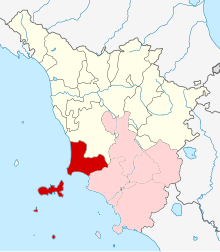Bishop of Massa Marittima
|
Diocese of Massa Marittima-Piombino Dioecesis Massana-Plumbinensis |
|
|---|---|

Massa Marittima Cathedral
|
|
| Location | |
| Country | Italy |
| Ecclesiastical province | Siena-Colle di Val d'Elsa-Montalcino |
| Statistics | |
| Area | 1,200 km2 (460 sq mi) |
| Population - Total - Catholics |
(as of 2004) 127,677 126,000 (98.7%) |
| Parishes | 53 |
| Information | |
| Denomination | Catholic Church |
| Rite | Roman Rite |
| Established | 5th century |
| Cathedral | Basilica Cattedrale di Cerbone Vescovo (Massa Marittima) |
| Co-cathedral | Chiesa Abbaziale di S. Antimo Martire (Piombino) |
| Current leadership | |
| Pope | Francis |
| Bishop | Carlo Ciattini |
| Map | |
 |
|
| Website | |
| www.diocesimassamarittima.it | |
The Diocese of Massa Marittima-Piombino (Latin: Dioecesis Massana-Plumbinensis) is a Roman Catholic eccleasistical territory in central Italy, and was known as Diocese of Massa Marittima before 1978. It is a historic church territory in Tuscany, suffragan of the Archdiocese of Siena.
The diocese has an area of 1,200 square kilometres, an overall population of 126,931, a Catholic population of 125,000, 60 priests, 4 permanent deacons, and 82 religious, and the present bishop, appointed on 15 December 2010, is Carlo Ciattini.
It was first mentioned in the eighth century. It grew at the expense of Populonia, an ancient city of the Etruscans. Populonia was besieged by Sulla, and in Strabo's time was already declining; later it suffered at the hands of Totila, of the Lombards, and in 817 of a Byzantine fleet. After this, the bishops of Populonia abandoned the town, and in the eleventh century, established their residence at Massa.
In 1226 Massa became a commune under the protection of Pisa. In 1307 it made an alliance with Siena, which was the cause of many wars between the two republics.
The first known Bishop of Populonia was Atellus (about 495); another was Saint Cerbonius (546), protector of the city, to whom Saint Gregory refers in his Dialogues. Among the bishops of Massa were Antonio da Massa Marittima (1430), a former minister general of the Franciscans, and legate of Pope Boniface IX; Leonardo Dati (1467), author of poetic satires; Alessandro Petrucci (1601), who embellished the cathedral and the episcopal palace; the Camaldolese Eusebio da Ciani (1719), who governed the diocese for fifty-one years. This see was at first suffragan of Pisa, but since 1458 of Siena.
...
Wikipedia
